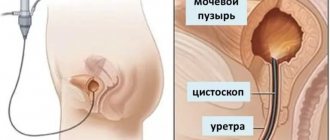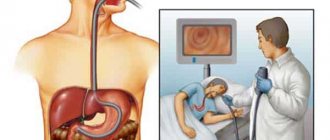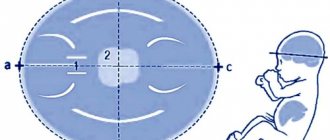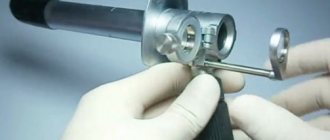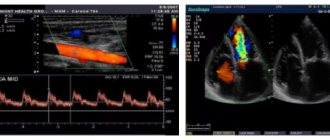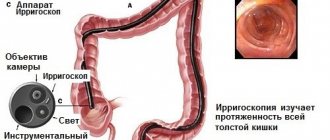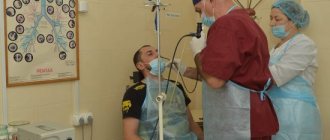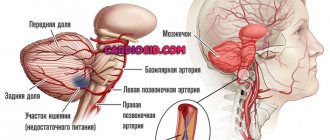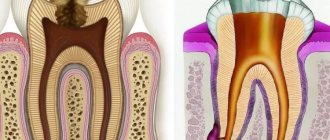- Home >
- Directory >
- What do spots on an MRI of the brain indicate?
Are you worried about your brain MRI images? Have you noticed dark or light spots in the images? Don't panic! Spots do not always indicate brain pathologies. What spots on MRI images can mean – we’ll tell you in this article!
Perivascular spaces of Virchow-Robin
Perivascular spaces are fluid that accumulates along the blood vessels supplying the brain. Another name for them is criblures. Every person has them, but usually they are small and are not visualized on photographs of the organ being examined.
When cerebral circulation is impaired, the criblures expand. Because they are filled with cerebrospinal fluid. They contain a large number of hydrogen atoms. And in this area the response signal will be of high intensity, which can be seen in the photographs as a white spot.
Enlarged perivascular spaces are detected in many patients. Most often they are harmless. A neurologist can accurately determine whether criblures are dangerous in particular cases.
Normal magnetic resonance imaging
The appearance of darkening and light areas on the diagnostic monitor is influenced by the echogenicity of the segments being studied. The organic tissue itself is gray, with darkish branches piercing it. Intracranial biofluid circulates through these channels. Black stripes indicate the sinuses of the head.
“Structures are normal” means that no focal changes are visualized, the brain tissue is developed and functioning correctly. MRI shows the normal shape of the vessels, the absence of hemorrhage, thrombosed areas and tumors.
The main signs of the norm:
- equipment signal without deviations;
- absence of inflammation in the gyri;
- the pituitary gland and the sella turcica are clearly visible;
- perivascular space without pathological changes;
- ventricles without pathologies.
A normal tomogram shows that there are no abnormalities in the ear canals, nerve fibers, orbit and nasal sinus. The brain is fully functioning.
Demyelinating pathologies
Demyelination is a pathological process that affects the myelin sheath of nerve fibers. The nature of the damage depends on its cause. She may be:
- Congenital (hereditary predisposition to the disease).
- Acquired (demyelination develops as a result of inflammatory processes in the brain).
Here are the diseases that show demyelinating lesions in the brain on MRI:
- Myelinopathy;
- Leukoencephalopathy;
- Multiple sclerosis.
Typically, demyelinating lesions appear as multiple white spots. The patient may perceive them as criblures because they are similar. Only a specialist can distinguish them from each other based on the severity and localization of the increased signal.
When is an x-ray prescribed?
In most cases, the reason for contacting a specialist is pain in the back. Pain can vary in intensity and extent, so X-rays are used to clarify the details.
Indications for radiography:
- pain in various parts of the spine;
- numbness of the upper and lower extremities;
- condition after injury for fractures, dislocations, subluxations of the vertebrae; identification or exclusion of curvature of the spinal column;
- to monitor the condition of the spine in the postoperative period;
- suspicion of an inflammatory or tumor process;
- suspicion of congenital anomalies /more often carried out in children/.
When the formalities are completed, and the X-ray is already in the hands of a specialist, then little remains to be done. First of all, the doctor will either confirm or deny his assumptions. Further treatment or correction tactics will be determined on an individual basis.
Gliosis in the medulla
Gliosis of the brain is the process of replacing neurons with glial cells. This is not an independent disease, but a consequence of other diseases.
Pathology in the form of foci of gliosis on MRI is usually detected in the following diseases:
- Encephalitis;
- Epilepsy;
- Hypoxia of brain structures;
- Long-lasting hypertension;
- Encephalopathy;
- Tuberculosis and multiple sclerosis.
Glial cells perform the work that dead neurons were supposed to do. It is thanks to them that the functions of the nervous system are restored after injuries. Single small lesions can only be detected on MRI. There are usually no other symptoms. If the underlying disease continues to kill neurons, a clinical picture emerges, and MRI images already show multiple pathological foci of the brain.
MRI helps detect the presence of gliosis, but in most cases does not tell what caused the changes. The differential diagnosis of dyscirculatory encephalopathy and multiple sclerosis is especially difficult. To decipher the results, you will need the help of at least two specialists with extensive experience: a neurologist and a neuroradiologist.
Treatment methods
The disease is incurable. The efforts of doctors are aimed at eliminating symptoms and improving the patient’s quality of life. Treatment of demyelinating diseases that affect the brain is prescribed depending on the type and nature of the course. Pharmaceutical agents that neutralize the manifestations of neurological syndromes are usually indicated. Symptomatic therapy includes drugs:
- Painkillers.
- Sedatives, sedatives.
- Neuroprotective, nootropic.
To treat rapidly progressing forms of multiple sclerosis, pulse corticosteroid therapy is used. Intravenous administration of large doses of the drug often does not give the desired result. In case of a positive reaction after a course of intravenous administration, corticosteroids are prescribed orally to prevent relapse. Corticosteroids can be combined with other immunosuppressive (immune-suppressing) drugs and cytostatics.
In 40% of cases, patients resistant to corticosteroid therapy respond positively to plasmapheresis (collection, purification and reintroduction of blood into the bloodstream). Cases of effective treatment of Balo's sclerosis with human immunoglobulins have been described. Therapy with folk remedies is ineffective. In parallel with drug treatment, patients are prescribed diet, physiotherapy, massage, and therapeutic exercises.
Brain swelling
White spots on an MRI may indicate swelling of the brain tissue. They develop against the background:
- tumors;
- injuries;
- ischemia;
- inflammation;
- hemorrhages.
At the initial stage of the disease, MRI reveals signs of perifocal edema in the form of light spots in the area of the affected area of the organ. If normal blood circulation is not restored, generalized edema develops. The brain swells. On an MRI, this is visible in a blurry picture in which the structures of the organ are not visible, since they all provide a high-intensity signal to the tomograph.
Features of the procedure
Non-invasive study of structural segments of the brain helps to find out how blood masses circulate through the vessels of the head. During the session, the magnetic field of the equipment is applied. The procedure is safe for the patient and painless.
Before scanning organ segments, there is no need to prepare the gastrointestinal tract, do enemas or follow a diet. Do not drink alcohol on the eve of the procedure. On the day of the session, you need to wear light clothing without metal elements, exclude accessories and cosmetics.
Scanning with a tomograph is performed in a lying position. A special belt system is used for fixation. You need to remain completely calm and not make any movements. To scan brain segments, the patient must lie still, without body movements.
Sites of Alzheimer's disease
MRI can be used to diagnose and monitor the progress of Alzheimer's disease. Focal formations in this disease are not white, but almost black. This is due to atrophic processes occurring in the organ, which begins to decrease in size.
The affected areas do not respond well to the radio signal sent to them, so they are called low signal intensity areas. Dystrophy of the posterior parts of the brain is especially well visualized.
Magnetic resonance imaging reveals structural abnormalities in the brain. Therefore, this research method is useful in diagnosing diseases that cause changes in the structure of the organ and the blood vessels that penetrate it. Anyone can distinguish an image of a healthy brain from an image with pathological foci. But only a doctor can make a diagnosis after a long study of the MRI results.
Dark spots on an MRI of the spine - consequences, prevention, manifestations, what they are
Have you been struggling with JOINT PAIN for many years without success?
Head of the Institute: “You will be amazed at how easy it is to cure your joints by taking the product every day for 147 rubles...
Read more "
X-ray examination is one of the most common ways to detect pathologies of the musculoskeletal system. An X-ray of the thoracic spine allows the doctor to draw a conclusion about structural disorders of the spine in this section.
OUR READERS RECOMMEND!
Our readers successfully use Artreid to treat joints. Seeing how popular this product is, we decided to bring it to your attention. Read more here...
When is the procedure prescribed?
The study is carried out if there are suspicions of various disorders in the musculoskeletal system. Chest X-ray is prescribed in the following cases:
- If the patient complains of back pain when bending and turning the body, as well as discomfort in the chest area. It is carried out to diagnose spinal pathologies.
- For scoliosis. With this disease, it is necessary to undergo regular examinations to track the dynamics of the disease.
- If there is a suspicion of a spinal injury in the thoracic region.
- If a tumor process is suspected.
- If infectious diseases are suspected.
- After operations to restore the spine.
- If there is a suspicion of a foreign body entering the respiratory tract.
Preparing and performing radiography
X-rays do not require prior preparation. However, for your own comfort, before the procedure, it is advisable not to consume foods that cause increased gas formation in the intestines.
Immediately before starting the procedure, the patient must undress to the waist and remove all metal jewelry. You must lie still during the examination.
For more accurate diagnosis, the study is carried out in two projections:
How to do the procedure:
- To carry out the procedure in the lateral projection, the person is on the diagnostic table of the device, lying on his side. The patient should raise the hand on the side on which he lies upward and rest his head on it. Legs should be bent, with the other hand you should grab your knees and press them to your stomach.
- To carry out the procedure in a direct projection, the patient lies on his back, legs straightened, arms lying along the body.
Functional tests are rarely used to study the thoracic region, because this section is characterized by low mobility. However, if the doctor considers such a test to be appropriate, then he himself decides in what position it is necessary to conduct the examination to determine the cause of the pain.
What can you see in the picture?
Only a doctor can evaluate and analyze the results of an x-ray. The images taken during the procedure are ready the next day.
What does an x-ray show:
- condition of joint spaces;
- the presence or absence of fractures, displacements;
- condition of the bone tissue of the vertebrae;
- condition of the vertebral surfaces;
- the shape of the vertebrae;
- size and location of the spinous processes of the vertebrae.
X-ray examination does not show muscles and ligaments, as well as soft tissues, the pathology of which can also be a source of pain. Therefore, if the x-ray showed the absence of pathologies, but there is pain when moving, then it is necessary to conduct studies that will determine the condition of the muscles and ligaments.
Because The examination shows all pathologies of the bone and cartilaginous system; the following diseases can be identified on the images:
- osteochondrosis;
- scoliosis;
- fractures;
- spinal tumors;
- vertebral displacement;
- pathological changes in the bone tissue of the spine;
- spinal tuberculosis;
- violations of the structure of joints;
- protrusion;
- thinning of intervertebral discs;
- genetic abnormalities of the spinal column;
- vertebral cracks;
- autoimmune pathologies - ankylosing spondylitis, rheumatoid arthritis, rheumatism.
An x-ray is a black and white image with the white areas being bone tissue. Cartilage tissue is not visible on the images, but the doctor can determine the thickness of the intervertebral disc by the distance between the vertebrae. Various dark spots may indicate neoplasms.
Contraindications
X-ray of the spine, like any other diagnostic, has a number of contraindications. The study should not be performed on pregnant women, since even a small dose of radiation, which is safe for an adult, can be harmful to the fetus.
The exception is life-threatening conditions, when the danger from the procedure is disproportionately small compared to the risk a woman is exposed to by refusing the study.
X-rays are not performed on children under 15 years of age for the same reason - the effects of radiation can be dangerous for an unformed child’s body.
The X-ray machine does not allow for a patient's weight to exceed 130 kg, so patients with a high degree of obesity cannot undergo examination due to excess weight. It does not make sense for an overweight person to undergo the procedure, because a large amount of subcutaneous fat makes the pictures unclear, and this prevents the doctor from obtaining the results necessary for diagnosis.
You cannot perform an x-ray if you have previously had studies with a barium suspension, since its presence in the body can blur the results of the x-ray, so you need to wait 4-5 days until the barium leaves the body.
X-rays are safe for the body if all rules are followed, but frequent examinations can have a negative impact on the body. Nevertheless, this influence is less dangerous than the lack of objective information about the state of health, so X-rays should be taken if indicated.
Igor Petrovich Vlasov
- Diagnostics
- Bones and joints
- Neuralgia
- Spine
- Drugs
- Ligaments and muscles
- Injuries
Cervicothoracic osteochondrosis: causes of the disease
Osteochondrosis is a dangerous disease. When it manifests itself in the cervicothoracic spine, gradual destruction of bone tissue occurs, especially aseptic damage to spongy tissue. The danger of the disease lies in its long development: a person can be sick for years and not know about it. Most often, the disease is chronic and leads to disability.
- Symptoms of osteochondrosis
- How is osteochondrosis treated?
Symptoms of osteochondrosis
The difficulty of diagnosing a disease such as cervicothoracic osteochondrosis lies in the wide range of external signs of the disease, which can lead to incorrect interpretation and misdiagnosis. The first signs of osteochondrosis of the cervicothoracic spine are very similar to the symptoms of vegetative-vascular dystonia or variant angina.
This is due to the nature of the manifestations of the disease:
- heartbeat disturbance;
- dyspnea;
- pain in the chest and heart;
- dizziness and headaches;
- rapid pulse;
- low pressure;
- blue circles under the eyes;
- gray skin.
As a result of the diagnosis, we can come to the conclusion that we have a classic case of VSD, but the devices will record slightly different indicators. An ECG will show the presence of an erratic heart rhythm, but an inexperienced doctor may not take this into account and, based on other obvious symptoms, make a diagnosis: angina pectoris.
Only after a couple of years, when more obvious signs are added to these symptoms, experienced specialists may notice an incorrect diagnosis. Unfortunately, often by this time the disease has already become chronic. In this regard, it becomes almost impossible to completely cure the disease.
Of course, with the necessary care and quality treatment, the disease may not have significant manifestations. With the subsequent progression of degenerative processes of the intervertebral discs, the disease becomes open: it can be recognized by a set of symptoms.
Characteristic symptoms for osteochondrosis of the cervicothoracic spine are as follows:
- Constant headaches that cannot be relieved with medications. This is due to the nature of the pain: medications thin the blood and help improve blood circulation in the head, but if you have osteochondrosis, the pain will be the result of a load on the spinal cord.
- Asthenic syndrome. Severe fatigue and fatigue appear.
- Dizziness and so-called dark circles and spots before the eyes often occur, which is evidence of a semi-fainting state. Dizziness is a rather dangerous symptom, because the patient can lose consciousness at any moment.
- Changes in blood pressure. This symptom occurs as a result of poor blood circulation in the head area. It is associated with constant tension in the neck muscles, which bear a heavy load. Also, unstable blood pressure is associated with abnormal metabolism, which develops against the background of osteochondrosis, strengthening it. As a result, it turns out that one symptom comes out of the other, since they have the same cause - back disease, leading to abrasion of the intervertebral discs.
- Impaired upright posture and coordination of movements. This symptom occurs partly as a result of overload of the nervous system, partly due to severe pain that occurs during movement. As a result of disc wear, osteophytes begin to grow, which then dig into the muscles and bring terrible pain.
- Tinnitus. Appears as a result of pressure changes. The vestibular apparatus reacts to intracranial pressure and makes itself felt by the sensation of extraneous noise in the ears.
- Neck hurts. This is due to excessive stress on the muscles.
- The appearance of goosebumps before the eyes. As a result of impaired blood circulation, oxygen starvation occurs, which leads to fainting.
- Cold hands and numbness in fingers. It appears at the first stage of the disease, but often this symptom is attributed to vegetative-vascular dystonia. In this case, this is not a gross mistake, because the nature of this symptom is always the same, regardless of the disease: poor circulation.
- Aching dull pain in the shoulder girdle and arms. The most obvious symptom characteristic of this particular disease. Localization of the disease in this particular area creates severe discomfort, which will only intensify as osteochondrosis progresses.
- Sore ribs. The patient may complain of itching and pain in the ribs. This is especially true when moving. Even with static work of the spine, a tingling sensation is felt in the ribs.
- Pain in the chest and heart area. Osteochondrosis curves the spine, which also affects the chest. Another reason is the destructive processes of improper metabolism. To relieve pain and chest compression, you need to adjust your diet and perform therapeutic exercises.
- Rachiocampsis. A clear symptom. Using palpation, an experienced doctor can easily identify spinal disorders.
The main rule for the patient: do not despair. The correct diagnosis is half the treatment! Of course, it is important to prepare yourself for long-term treatment.
Typically, osteochondrosis in this part of the spine is characterized by attacks of pain that occur periodically. As the disease progresses, such relapses occur more frequently.
The pain symptom intensifies during sudden changes in body position, when turning the head or bending the neck. Another symptom indicating the disease is snoring.
It occurs due to constant tension in the neck muscles, which do not relax even during sleep.
Periodic toothaches may also occur, and there may even be a burning sensation of the skin on the neck and head. The pain is often accompanied by nausea and dizziness.
If the disease is not treated promptly, this can lead to compression of the vertebral artery by osteophytes, which can lead to the development of brain disorders.
It is precisely because of these symptoms that osteochondrosis of the cervicothoracic spine is confused with vegetative-vascular dystonia.
How is osteochondrosis treated?
Treatment of this disease is almost impossible in the final stages, so it is best to start early. Osteochondrosis can be easily slowed down in the first stages. Unfortunately, it is impossible to completely recover from it.
To prevent the disease from progressing, it is necessary to completely change your lifestyle: go on a special diet, do therapeutic exercises, periodically undergo a course of treatment and consult with your doctor.
You also need to be attentive to climate change, so when going to a resort, inform your doctor. Let a specialist advise you on vitamins or medications.
Treatment includes:
- drug therapy;
- herbal medicine and dietary supplements;
- therapeutic exercises, massage, reflexology.
First of all, the patient is prescribed painkillers and anti-inflammatory drugs. Usually these are non-steroidal drugs aimed at relieving pain symptoms. It is also very important to remove the inflammatory process that stimulates the destruction of intervertebral discs.
Next, corticosteroids must be prescribed. These are drugs that are administered as injections. They are able to restore cartilage tissue and participate in the metabolism of bone tissue. Thus, doctors stop progressive osteochondrosis. Corticosteroids can potentiate the effect of analgesics, which makes it possible to reduce the dosage without compromising effectiveness.
Dietary supplements are also part of the treatment. The use of active additives and herbal remedies can improve the condition of bone and muscle tissue. Dietary supplements have a positive effect.
Ointments and gels are also often used. I would like to immediately warn you that the use of many of them does not affect the treatment process and does not help your spine at all. The maximum that ointments can do is improve the condition of the skin. No matter what you hear in commercials and in the pharmacy: don’t believe it, they won’t help.
OUR READERS RECOMMEND!
Our readers successfully use Artreid to treat joints. Seeing how popular this product is, we decided to bring it to your attention. Read more here...
In addition to drug treatment, the patient will definitely have to undergo therapeutic exercises and physiotherapeutic procedures. They will have a positive effect and help you forget about the disease.
Source: https://gips.sustav-med.ru/narodnyie-sredstva/temnye-pyatna-na-mrt-pozvonochnika/
Guillain-Barre syndrome
An acute inflammatory disease characterized by “demyelinating polyradiculoneuropathy.” It is based on autoimmune processes. The disease manifests itself as sensory disturbances, muscle weakness and pain. It is characterized by hypotension and disorder of tendon reflexes. Respiratory failure may also occur.
All patients with this diagnosis should be admitted to the intensive care unit. Since there is a risk of developing respiratory failure and a ventilator may be required, the department must have intensive care. Patients also need proper care with the prevention of bedsores and thromboembolism. It is also necessary to stop the autoimmune process. For this purpose, plasmapheresis and pulse therapy with immunoglobulins are used. Full recovery of patients with this diagnosis should be expected within 6-12 months. Deaths occur due to pneumonia, respiratory failure and pulmonary embolism.

